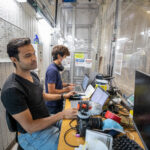Browse Resources by Year
The kingdom of Bahrain is the smallest country in the Middle East, measuring only 294 square miles with a population of 1.7 million people. The small nation is an ambitious emerging playerin the space sector.
Read MoreSpace-related employment has been growing steadily over the past two years, but the declining financial market could finally be slowing the industry’s growth. U.S. Bureau of Labor Statistics (BLS) employment data and space job boards both hint at reduced hiring over the past few months. However, the latest BLS employment outlook shows that many space jobs have a higher-than-average growth projected over the next decade.
Read MoreCongressional gridlock delayed a 2023 spending plan for U.S. government space programs, which have made up about 12 percent of the global space economy in recent years. The delay stalled budget increases for NASA and the Pentagon topping $6 billion, but a stopgap measure keeps agencies operating at 2022 spending levels.
Read MoreNASA’s newest spacesuits, under a contract announced in September, will be rented by the agency much like tuxedos for a wedding or high-school prom night. Unlike suits in use since the Space Shuttle program, they’re designed to fit astronauts of any size, taking the agency back to the early days when all those headed to space got a custom suit.
Read MoreAstronaut safety in space is always a top priority, especially as deep-space missions become a reality and the risk of medical emergencies increases. Alongside traditional 3D printing applications, bioprinting has the potential to support astronauts for medical issues ranging from small abrasions to lifesaving organ transplants.
Read MoreGetting to space and keeping the space industry moving ahead takes a diverse group of people with a wide range of talents, including many who didn’t picture themselves as part of the race to the stars just a few years ago. Here are few of them.
Read MoreWhile the space industry struggles with a tight employment market, the Space Force, a key military pipeline for building the future civilian space workforce, is deluged with youthful applicants. Only 3% of would-be recruits will make the cut.
Read MoreThe space industry relies on skilled individuals from a wide variety of fields to enable the cutting-edge developments taking place in this sector. While many countries do not regularly produce metrics on the size of their workforce, these data are available for several major space actors, including the United States, Europe, Japan, and India.
Read MoreU.S. federal budget delays are continuing to put new space programs on hold as Congress works to agree on spending for FY2023.
The latest episode of Space Matters brings together former NASA administrator Jim Bridenstine, BryceTech founder and CEO Carissa Christensen, Constellation Advisory founder Patricia Cooper, and former U.S. congressman Bob Walker to discuss U.S. budget delays and the space launch industry.
Read More








